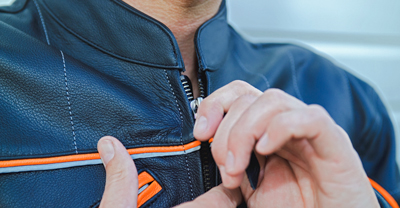Motorcycle camping 101: How to choose your route and campsite


0 min. read
So, you’ve decided to go on a motorcycle camping—or motocamping—trip. After all, few things match the freedom of the open road followed by a night under the stars. But where do you start?
Motocamping can be a rewarding adventure, but it benefits from some planning to help make the experience as smooth as possible. This guide will help you find scenic routes, choose campsites, and plan your next motocamping trip.

Get a motorcycle insurance quote today.
Match your motorcycle camping route to your riding style
Each ride and rider is different. When choosing a route, think about how you want to experience the road, the campsite, and everything in between.
Prefer plenty of time to relax?
If you enjoy setting up the perfect camp, exploring nearby attractions, and relaxing in the great outdoors, a shorter route could be a good fit. Plenty of routes can be ridden in just a few hours, giving you plenty of time to unwind at your campsite. Shorter doesn’t mean less scenic. The routes below are proof—each one offers beautiful views without taking up your whole day.
Routes that leave more time for camp:
Needles Highway: A quick taste of the Black Hills complete with granite spires and tunnels → Camp at Custer State Park
Tunnel of Trees: Canopy-covered riding near Lake Michigan → Camp at Petoskey State Park
Pig Trail Scenic Byway: A winding 19-mile cruise through the Ozark National Forest → Camp at Redding Recreation Area
Rather spend the day riding?
For riders who enjoy the journey as much as the destination, longer scenic routes are a great choice. Some official routes span hundreds of miles and cross multiple state lines. If you have the time, choosing a longer route with plenty of camping spots along the way could make for a memorable adventure.
Scenic rides that go the distance:
Pacific Coast Highway: 650 miles of cliffside views, coastal curves, and gentle ocean breezes → Camp at Redwood National and State Parks
Blue Ridge Parkway: Sweeping Appalachian landscapes through Virginia and North Carolina → Camp at Stone Mountain State Park
Natchez Trace Parkway: Historic ride through Southern woodlands and rolling hills → Camp at Tishomingo State Park
Up for a challenge?
Maybe you're a more experienced rider looking to trade a relaxing ride for something more adrenaline-pumping. With the right gear setup, you can take on routes with tight curves and steep elevation changes to make your motocamping trip more exciting.
Challenging rides for confident riders:
Beartooth Highway: Gorgeous mountain views paired with hairpin turns at over 10,000 feet → Camp at Parkside Campground
Tail of the Dragon: 318 curves in 11 miles—need we say more? → Camp at Cheoah Point Campground
Million Dollar Highway: Narrow mountain passes, steep drop-offs, and few guardrails → Camp at Molas Lake Campground

Choose a campsite that works for your ride
Not all campsites are suited for motorcycle travel—and that’s especially true when you’re riding fully loaded for motocamping. Some sites are walk-in only or tucked deep in rugged terrain, while others are easy to access and offer basic comforts like bathrooms, picnic tables, or even a place to grab a bite nearby.
Before you unpack your saddlebags, here are a few questions to help you find a site that fits:
Is it legal to camp there? Are permits or fees required?
Can you reach the site by motorcycle—or does it call for an adventure bike and some off-road experience?
What kind of setup are you after? Access to restrooms, water, or nearby trails might be dealbreakers—or just nice-to-haves.
Where to find a campsite
National parks and forests
Federal lands—like national parks and forests—can be a great option for motocamping. Many scenic motorcycle routes are positioned near these locations, making them a convenient place to stop and camp. Here are a few tools and resources to help you plan your stay:
Park websites: Camping details are usually under the "Plan Your Visit" tab, often under "Eating & Sleeping."
NPS app: This mobile app offers interactive maps, tour info, and camping options. For most parks, camping details are found under the "Where to Stay" menu.
Recreation.gov: Many federal campgrounds require reservations, which can be made through this site. It lists camping and recreation opportunities across the country.
Private campgrounds
While there are plenty of national, state, and county parks out there, sometimes private campgrounds offer special amenities—like swimming pools, dog parks, or unique lodging options. Just be sure to check the reviews and ask questions to ensure the site fits your setup.
KOA (Kampgrounds of America): With over 500 locations across North America, KOA offers everything from basic tent sites to cabins and glamping stays.
Hipcamp: Often called the Airbnb of camping, this online platform connects travelers with private landowners offering camping and glamping experiences across the country.
Preparing for the unexpected on your ride
Unpredictable weather
Always check the weather before you head out on your route, and consider other arrangements if conditions like ice and flooding make traveling or camping unsafe.
Backup plans
Taking the long, scenic route to your campsite can be exciting if you're a fan of the great outdoors. But what happens if there's traffic along the way? Or what if road closures mean you need to turn back? Always have a backup plan and familiarize yourself with alternative routes before you go.
Extra stops and fuel
Motorcycles don’t carry as much fuel as most cars, so it’s a good idea to plan your refueling points ahead of time—especially in rural areas. Map out nearby gas stations, food stops, and rest areas along your route. If you’re riding with others, sync up your rest stops to stay safe and stick together.
From winding highways to wooded campsites, stay protected
Whether you're in it for the long scenic ride or an adrenaline-filled challenge, motorcycle insurance can help protect you and your bike on your motocamping adventures. Dairyland®, a brand of the Sentry Insurance Group, offers flexible coverage options and potential discounts for riders like you. Reach out to learn more about what’s available.

Start your free motorcycle insurance quote today.
The general information in this blog is for informational or entertainment purposes only. View our blog disclaimer.










